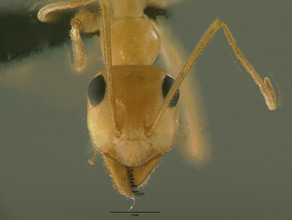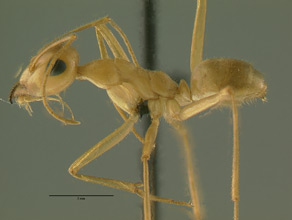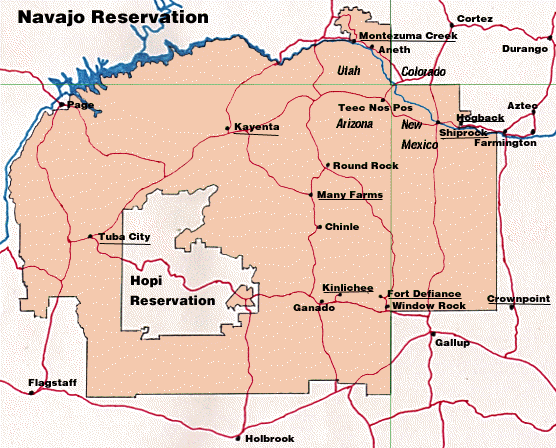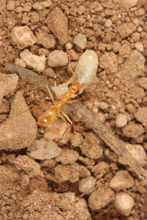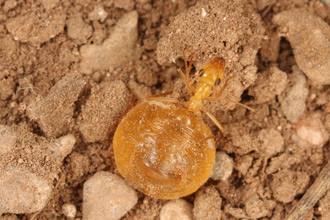- Identification
- The genus Myrmecocystus can be differentiated from other Nearctic Formicinae by their elongate maxillary palpi. The fourth segment is as long as, or longer than, the combined lengths of the two following segments. Differing from Myrmecocystus navajo by its light yellow, or a light yellow with a brownish tinge (southern portions of its range), color. These ants have large eyes and an abundant pubescence on the head, pronotum and gaster. The polymorphic workers include a relatively large size range, at least when compared to a Navajo Reservation congener they otherwise resemble (Myrmecocystus testaceus).
- Biology
- This species is one of the most commonly encountered honeypot ant in southwestern North America. Their colonies entrances are marked by a crater mound. Foragers commence foraging in an outpouring from the nest that typically occurs just after sunset.
- additional biology notes...
- Distribution
- Range
- United States and Mexico. Central Mexico north to Colorado and Utah, westward to California and Lower California.
- Navajo Reservation Records
- Collection records being processed.

Drawing of worker from Snelling (1976)
- Additional Notes
- Snelling (1976)
-
- This is the most extensively studied of all the species of Myrmecocystus. McCook (1882) published the results of his studies in Colorado; these were supplemented by Wheeler (1908). Briefly, the species forages at night, less commonly on cool, overcast days. Workers emerge singly and seek out food items. The ants derive much of their sustenance from exudates from galls on oaks (Quercus spp.) as well as from aphids and pseudococcids (Homoptera). They also take juices from bruised or broken fruits which may be available, such as those of cacti (Opuntia spp.) and nectar from a wide variety of flowers and from extrafloral glands.
- The ants are by no means wholly dependent upon nectar and fruit juices, for they are assiduous general scavengers. In general, however, this species seems not to be an active predator. I have rarely observed it attacking live insects. On those occasions when I have made such observations, workers were picking up insects attracted to lights at night. Foragers would rush up to an insect and grasp it with the mandibles. If the prey was much smaller than the ant it was immediately carried away. If of a size approximately equal to that of the ant and struggled, it was released and the ant would dart away.
- Most protein material brought to the nest consists of fragments of already dead, often desiccated arthropods. Colonies observed in southern Arizona regularly picked up head capsules of Pogonomyrmex spp. from detritus piles around the nests of the harvester ants. Foraging is an individual matter for the most part. The usual pattern seems to consist of an initial mass exodus of workers at the onset of the foraging period. The workers quickly radiate in all directions. Obviously, if there are previously visited sources of food in a limited area, such as a plant harboring large numbers of aphids, a sizable percentage of the foragers ultimately arrive there, but there are no foraging "trails" as such.
- This is a species of the Sonoran and Transition Zones, with most records from areas in the Sonoran. Within the Sonoran Zones, it appears to be about equally abundant in Lower and Upper Sonoran habitats. In Colorado, Gregg (1963) recorded this species (as Myrmecocystus mexicanus hortideorum) from Pinon-Juniper Woodland, Pinon-Cedar-Oak Woodland, Sagebrush Desert, Sagebrush-Greasewood Desert and Saltbush Desert. The elevational amplitude in Colorado was noted to be a little over two thousand feet, but Gregg correctly noted that over the entire range of the species it would be much greater. In southern California, the lowest elevation is below sea level (-225 feet) at Salton Sea Beach and the highest is 5185 feet above sea level at Salton View in Joshua Tree National Monument, less than 45 miles to the north. The greatest elevation record is 8000 feet, 6 mi NE Santa Fe, New Mexico.
- McCook (1882), Wheeler (1908) and Gregg (1963) have noted that the tumulus marking the entrance of the nest is crateriform and is constructed of coarse gravel and pebbles. Occasionally, nests may be situated in fine, deep sand, in which case the tumulus consists of much finer particles, though even then the coarsest particles available are used. Nests of this species seem always to have but a single entrance which may be as much as 2.3 cm diameter at the surface.
- Flight activities of the sexual forms are not well documented and most of the available reproductives have been removed from nests. The mating flights occur during summer or fall rainy seasons, apparently in late afternoon or early evening following an afternoon rain.
- Repletes
- Myrmecocystus are better known to naturalists by their common name - honeypot ants. While there are numerous varieties of honeypot ants throughout the world this particular genus is restricted to dry habitats in southwestern North America. Individual species can be found from Washington, south to central Mexico and east to Texas. The genus is most diverse in southern California, which hosts eighteen of the twenty-seven named species. The common name of the ants from this genus highlights an unusual feature of their biology. One of the worker castes serves as a living food storage repository. These large workers, or repletes, have gasters that are able to expand to a remarkable degree.
- Repletes are a fascinating adaptation to arid and semi-arid habitat life. Myrmecocystus live in areas where rain is sparse and typically arrives seasonally. The moisture triggers plant growth and reproduction, which in turn creates food resources for many other organisms. Carbohydrate rich exudates of sap sucking insects (aphids and others), galls and extrafloral nectories can readily be gathered in great quantities by foraging ants. Over the course of the year nothing else compares to this seasonally abundant profusion of liquid nutrients. Repletes are an effective way of solving the problem of dealing with the boom and bust nature of these valuable liquid food resources.
- Nests of Myrmecocystus go deep underground and the repletes are typically located in the lower reaches of the nest. Snelling (1976) felt they were placed where there is permanent soil moisture. This positioning of the repletes in the soil column allows for the ants to be kept cool and maintained in a humid environment. The deeper confines of the nest are also presumed to be safer from predators that could potentially prey upon the nutrient rich ants. Other ants, badgers, coyotes and even humans have exploited honeypot ants as a food resource.
- Foraging ants collect honeydew and nectar, return to the nest and regurgitate their food to the repletes. These living storage units suspend themselves from the ceiling of a nest chamber. Individuals are often found in clusters while overall they may be found in numerous chambers in a colony. Engorged individuals can become confined to the chamber where they become filled with liquid. The repletes of some species become the size of small grapes. The transfer of food is reversed during leaner times of the year. Workers will tap their antenna upon the head, mandibles and antenna of a replete to solicit food, which is then readily provided to the repletes' nestmates.
- Etymology
- Geographic. "Of Mexico." The types are from Mexico.
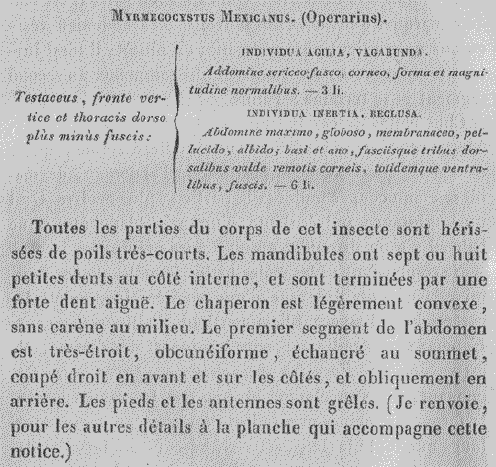
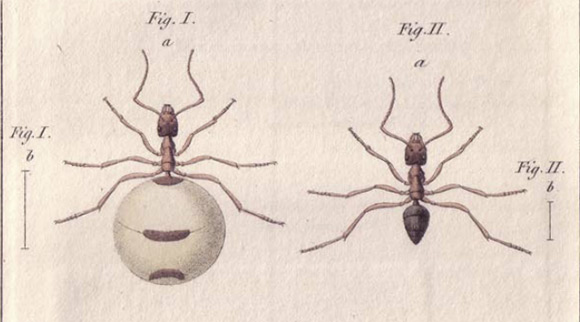
Neotype worker and 31 neoparatype workers designated by Snelling (1976): MEXICO, State of Chihuahua: 21 mi SW Jimenez, 23 Dec. 1958 (A. S. Menke & L. A. Stange). Neotype and neoparatypes in LACM; two neoparatypes each in AMNH, MCZ, and USNM.
- Literature
- Gregg, R. E. 1963. The ants of Colorado, with reference to their ecology, taxonomy, and geographic distribution. University of Colorado Press, Boulder.
- McCook, H. C. 1882. The honey ants of the Garden of the Gods, and the occident ants of the American plains. J. B. Lippincott & Co., Philadelphia.
- Snelling, R. R. 1976. A revision of the honey ants, genus Myrmecocystus (Hymenoptera: Formicidae). Natural History Museum Los Angeles County Science Bulletin. 24:1-163.
- Wheeler, W. M. 1908. Honey ants, with a revision of the American Myrmecocysti. Bulletin of the American Museum of Natural History. 24:345-397.
- A note about these publications. The literature cited here is not meant to be an exhaustive list of papers published about this species.
Page authored by David Lubertazzi and Gary Alpert
